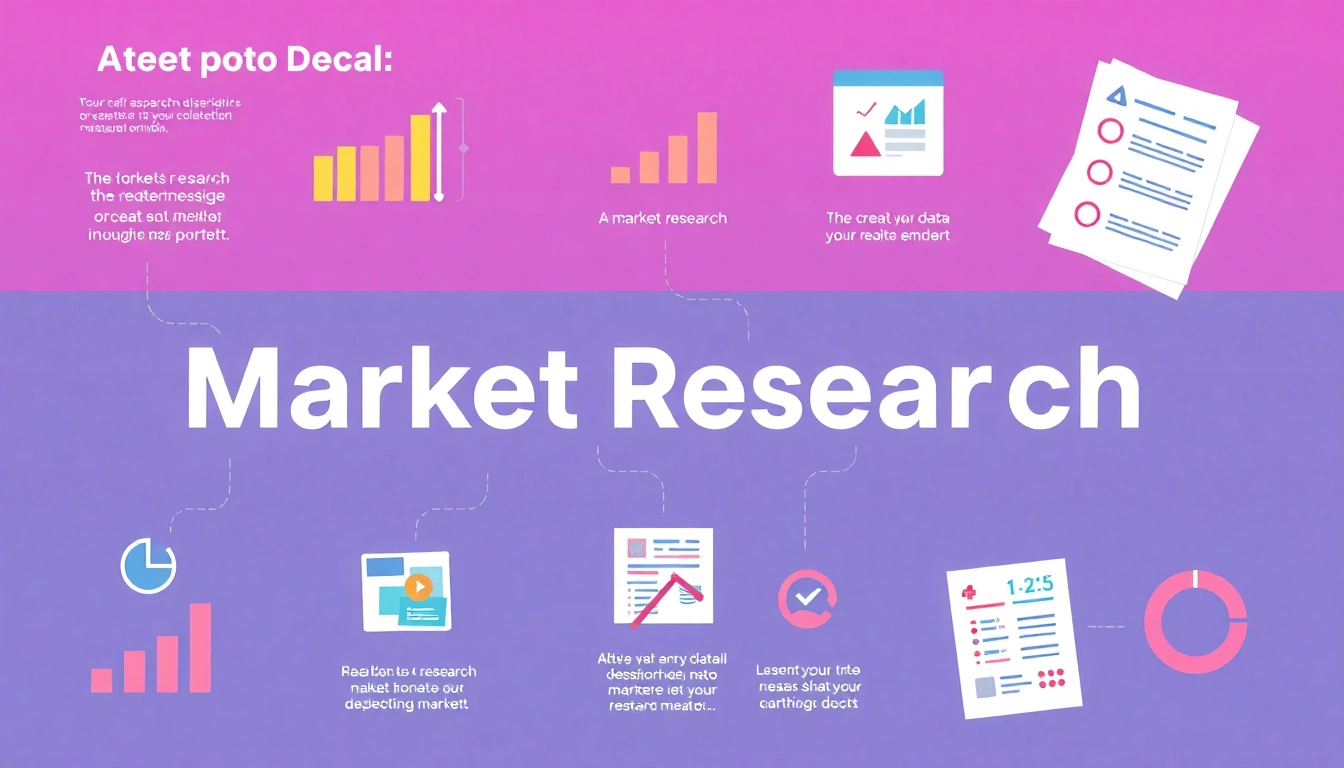Effective Strategies for Market Research Data Collection to Drive Business Insights
Understanding Market Research Data Collection
What is Market Research Data Collection?
Market research data collection refers to the systematic approach of gathering quantitative and qualitative information concerning specific markets, consumers, and businesses. This process is essential for companies to understand the intricacies of market dynamics, consumer preferences, and competitive landscapes. It encapsulates various techniques aimed at sourcing valuable insights that aid organizations in making informed decisions. By leveraging techniques such as surveys, interviews, and observational studies, businesses can aggregate meaningful data that reflects the realities of their target markets. As organizations pursue market research data collection, they build a foundation for driving strategy, enhancing products, and effectively reaching customers.
Importance of Effective Data Collection Techniques
The significance of effective data collection techniques in market research cannot be overstated. Reliable data enables businesses to decipher consumer behaviors, emerging market trends, and competitor strategies. This insight facilitates several key benefits:
- Enhanced Decision-Making: Accurate data provides a solid basis for strategic decisions, whether launching new products or adjusting marketing strategies.
- Risk Mitigation: Understanding market variables helps organizations anticipate potential challenges and mitigate risks effectively.
- Customized Marketing Strategies: Companies can tailor their marketing efforts based on specific consumer preferences, leading to improved engagement and conversion rates.
- Competitive Advantage: Through consistent and insightful data collection, businesses can maintain a competitive edge by staying ahead of market shifts and evolving consumer needs.
Challenges in Market Research Data Collection
Despite its numerous advantages, market research data collection presents specific challenges that organizations must navigate:
- Data Quality and Reliability: Poorly designed data collection methods can lead to inaccurate results, compromising the validity of research findings.
- Respondent Bias: The possibility of biases lurking in survey responses or interviews can skew results, leading to misguided conclusions.
- Cost and Resource Allocation: Conducting comprehensive market research can be resource-intensive, requiring significant time, money, and manpower.
- Adapting to Technological Changes: With the constant evolution of technology, staying updated on the latest data collection tools and methodologies is critical but can be challenging.
Types of Market Research Data Collection Methods
Surveys: Crafting Questions that Yield Insight
Surveys are among the most commonly utilized methods for market research data collection. They facilitate the gathering of vast amounts of data in a relatively short time frame. However, the effectiveness of surveys hinges largely on how questions are crafted.
When designing surveys, it’s imperative to consider:
- Clear and Concise Wording: Questions should be straightforward to avoid confusion among respondents.
- Variety of Question Types: Incorporate different formats (e.g., multiple-choice, Likert scale, open-ended questions) to capture nuanced insights.
- Testing the Survey: Conducting a pilot test can help identify potential issues before full deployment.
Utilized effectively, surveys can reveal preferences, satisfaction levels, and the likelihood of future purchases among consumers.
Interviews and Focus Groups: Gaining Depth in Responses
While surveys are excellent for breadth, interviews and focus groups offer depth. Personal interviews allow for one-on-one interactions, providing researchers with the opportunity to dive deeply into participant motivations, perceptions, and experiences. Focus groups, on the other hand, promote interaction among participants, yielding diverse viewpoints that can lead to innovative ideas.
Key considerations for conducting interviews and focus groups include:
- Skilled Moderation: An effective moderator can facilitate the conversation, ensuring all voices are heard while steering discussions toward relevant topics.
- Creating a Comfortable Environment: Ensuring participants feel at ease can enhance the quality of interactions, leading to richer data.
- Recording and Analyzing Results: Capturing discussions through audio recordings or notes is crucial for thorough analysis.
Observational Techniques: Understanding Consumer Behavior
Observational techniques involve the systematic observation of consumer behavior in natural settings. This method provides actual insight into how consumers interact with products, advertisements, or services, eliminating potential biases introduced by self-reporting in surveys or interviews.
Types of observational techniques include:
- In-Store Observations: Monitoring how customers navigate a retail environment and interact with products can provide valuable data.
- Online Behavior Tracking: Analyzing user patterns on websites can help companies understand what attracts and retains customers.
- Ethnographic Studies: A more in-depth approach, where researchers immerse themselves in consumer environments to gather insights.
Best Practices for Data Collection in Market Research
Choosing the Right Data Collection Method
Selecting an appropriate data collection method is crucial for obtaining valuable insights. Considerations should include:
- Research Objectives: Clearly define what information is needed and why, which will guide the selection of methods.
- Target Audience: Understanding the demographics and preferences of the audience can influence which methods will yield the best results.
- Budget and Resources: Assess available resources to determine feasible methods without compromising quality.
Implementing Ethical Guidelines
Operating within ethical boundaries is paramount in market research. Ethical considerations must include:
- Informed Consent: Participants should be fully aware of the research intentions and how their data will be used.
- Anonymity and Confidentiality: Safeguarding participant identities promotes trust and encourages honest responses.
- Transparency: Clear communication about the research process and objectives fosters integrity and builds credibility.
Utilizing Technology for Efficient Data Gathering
Modern technology plays a critical role in enhancing the efficiency of market research data collection. Online survey platforms, data analytics software, and consumer tracking tools empower researchers to gather and analyze data more effectively. Incorporating these technologies enables:
- Real-Time Data Collection: Respondents can participate from anywhere, leading to faster data accumulation.
- Advanced Analytics: Automated tools allow for streamlined data analysis, identifying trends and patterns rapidly.
- Cost Effectiveness: Online tools often reduce the costs associated with traditional data collection methods.
Analyzing Collected Data for Actionable Insights
Data Analysis Techniques in Market Research
Once data has been collected, the next crucial step is analysis. Different data analysis techniques can be employed based on the nature of the data:
- Quantitative Analysis: Techniques like descriptive statistics, regression analysis, and Chi-square tests can analyze numerical data gathered from surveys.
- Qualitative Analysis: Techniques such as thematic analysis and narrative analysis can interpret trends and sentiments from interview or focus group data.
- Mixed Methods: Combining both quantitative and qualitative analyses often provides the most comprehensive insights.
Transforming Data into Strategic Decisions
The ultimate goal of market research data collection is to inform strategic decisions. Translating analytical findings into actionable strategies entails:
- Identifying Key Insights: Focus on findings that directly align with business objectives, consumer needs, and market dynamics.
- Collaboration Across Departments: Encourage teams from marketing, product development, and sales to collaborate on utilizing data effectively.
- Continuous Monitoring: Recognize that market conditions shift, necessitating ongoing observation and adaptation of strategies.
Case Studies: Successful Implementation of Data Insights
Examining successful case studies can provide invaluable lessons for implementing data insights effectively. For example:
- Coca-Cola: Implemented an extensive market research initiative to understand shifting consumer preferences, leading to the introduction of healthier product options, significantly boosting sales.
- Netflix: Analyzed user viewing data to create targeted content, resulting in increased viewer satisfaction and subscriptions.
- Amazon: Utilizing customer feedback and purchasing behavior analytics to refine product recommendations and marketing strategies, enhancing user engagement.
Future Trends in Market Research Data Collection
The Impact of AI and Automation
The advent of artificial intelligence (AI) and automation technologies is revolutionizing market research data collection. AI-driven tools can automate survey creation, data gathering, and analysis, minimizing human error and optimizing efficiency. Furthermore, machine learning models can predict consumer behavior trends accurately by analyzing vast amounts of historical data.
Adapting to Changing Consumer Behaviors
As consumer behaviors evolve with technological advancements and shifting cultural dynamics, market researchers must adapt. Continuous learning and agility in research methods will be paramount to staying relevant and informed about consumer needs.
Innovative Tools for Enhanced Data Collection
The future may see the emergence of innovative tools such as virtual reality (VR) environments for ethnographic studies or blockchain technology to enhance data privacy during collection. Keeping abreast with these developments will aid organizations in refining their data collection processes for improved insights.










